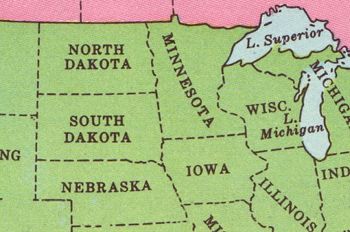South Dakota (U.S. state): Difference between revisions
imported>Hayford Peirce (simplified sentence structure) |
imported>James F. Perry (→Politics and government: add "current issues") |
||
| Line 21: | Line 21: | ||
* Structure of state government (incl. key personnel) | * Structure of state government (incl. key personnel) | ||
* Finance and taxation | * Finance and taxation | ||
* current issues | |||
==Economy== | ==Economy== | ||
Revision as of 21:05, 3 September 2009
South Dakota is one of the states constituting the United States of America; it entered the Union as the 40th state on November 2, 1889, the same date as North Dakota. Its area is 77,116 square miles (199,730 square kilometers). Its estimated population in 2008 was 804,194. South Dakota is a Great Plains state bordered on the north by North Dakota, on the east by Minnesota and Iowa, on the south by Nebraska, and on the west by Wyoming and Montana. The state is split by the upper Missouri River into "east-river" and "west-river" regions. The capital is Pierre.
The University of South Dakota, situated in Vermillion, opened in 1882. South Dakota State University in Brookings was established in 1881.
The most important tourist attraction of the state is Mount Rushmore National Memorial, in the Black Hills. Here 60 feet (18 m) high heads of four former United States presidents can be admired: George Washington(1732–1799), Thomas Jefferson (1743–1826), Theodore Roosevelt (1858–1919), and Abraham Lincoln (1809–1865).
Land
- Physiography (land forms)
- Rivers and drainage, lakes
- Climate
- Soil
- Flora
- Natural "resources"
Demographics
- including native peoples
Politics and government
- Structure of state government (incl. key personnel)
- Finance and taxation
- current issues
Economy
- Agriculture and livestock
- industry (manufacturing)
- Mining
- Transportation
Social, cultural, and educational
- Media
- Education
- Libraries
- Arts
- Religion
Parks and recreation
- State parks
- Federal lands (National Parks, National Forests, Wilderness areas)
- Points of interest
